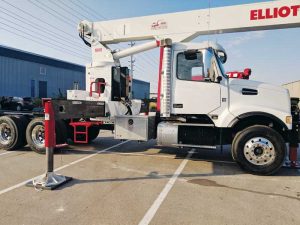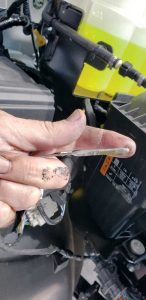Tips for limiting expensive equipment downtime
by brittney_cutler | 26 October 2021 9:00 am
 [1]
[1]There are a few ways in which a company can try to avoid downtime with today’s modern trucks.
By Bryan Wilkerson
Today’s challenging economic climate brought on by the pandemic has resulted in business uncertainty. Many factors are outside business owners’ hands. However, one thing that is within control, and one that has the biggest economic impacts on the modern sign company, is downtime.
The question is how can companies who own installation equipment or provide installation services, limit downtime and maximize use of equipment?
Downtime, in most jobs, is figured as billable hours. If the equipment is not running, the billable hours stop. On top of this is the additional headache of dissatisfied clients, as well as a backlog on normal production when the equipment returns to operation.
The single most conspicuous installation equipment are lifts, such as boom trucks, aerial cranes, man lifts, bucket trucks, and service ladders. There are a few ways in which a company can try to avoid downtime with today’s modern trucks.
Engine oil changes
Possibly the most critical operation is to do regular engine oil changes. Most manufacturers set a mileage number as to when the truck’s engine oil should be changed, However, as most modern lift equipment currently runs on the power take-off (PTO) mode, it means high idle times for the engine, but zero miles showing on the odometer.
 [2]
[2]Possibly the most critical operation is to do regular engine oil changes.
Engine oil not only lubricates the moving parts of the engine, but it also helps cool internal parts and may help drive the injection system on a diesel engine. This makes it critical for engine oil to be changed on a regular basis. The frequency of oil change should be based more on how the engine is run (idle time and mileage) than the miles driven.
Hours of engine operation can severely affect the life and performance of the engine and its oil. Many experts consider an hour of engine idle time (and PTO equipment operation time) to be equal to 48 km (30 miles) driven. Hence, one-hour of truck idle time equals 48 km of drive time.
This is even more applicable to the modern emission-compliant engines and the high temperatures and extreme conditions they are operating at.
Driven mileage versus engine hours (equivalent mileage)
• One driven mile = 1.6 km.
• One hour of idle time = 48 driven kms (30 driven miles) equivalent.
• If you drive 96.5 km (60 miles) per day and each day if you idle your engine for six hours, it equals 96.5 km (60 miles) plus 290 km (180 miles) = 386 km (240 miles) a day.
• If you drive 96.5 km (60 miles) per day x 20 days per month = 1931 km (1200 miles) 240 (hours plus miles) miles per day x 20 days per month = 7725 km (4800 miles)
• 1931 km (1200 miles) per month x 12 months per year = 23,174.5 km (14,400 miles) 7725 km (4800 miles) per month x 12 months per year = 92,698 km (57,600 miles).
• Oil changes every 11,265 km (7000 miles) = two oil changes per year
• Two oil changes per year = 46,349 km (28,800 miles) per oil change.
Oil changes also have the added benefit of not only prolonging the life of the engine and its components, but they also reduce emissions output because of the reduction of additional carbons in the oil. Regular oil changes also lead to a more fuel-efficient engine. The benefits are both to your bottom line and the environment.
 [3]
[3]Hours of engine operation can severely affect the life and performance of the engine and its oil.
Extreme idle times
Extreme idle times can also lead to carbon build-up in the particulate filters in the modern emissions engine as the diesel oxidation catalyst never reaches temperatures high enough to burn out and oxidize the spent carbon particles. This could require having the particulate filter removed and cleaned out at the dealership or repair facility that is properly equipped with the machinery to do a complete clean out.
Again, this can be expensive both in terms of the price of the service as well as downtime when the equipment should be out doing service or installation.
Another point on the changing of engine oil is that many vehicle manufacturers recommend separate summer-weight oils and a winter-weight oil. Recommended oils greatly help start up the engine in winter and reduce wear and high heat resistance in the summer, resulting in ease of use, saving in wear and tear, and environmental protection.
Another thing to consider is to make sure the oil used in the truck has all the proper additives the vehicle requires. Some common additives, such as zinc, phosphorus, graphite, and bismuth, have been greatly reduced or completely removed from certain types of oils as these can cause failures in engines with mechanical injection/injection pumps and flat tappet cam shafts and lifters. Using oils that contain these additives can also lead to mechanical issues. When in doubt, check with the truck manufacturer’s owner’s manual.
This is not a completely new concept, but it has become increasingly relevant. Engine hours can be measured with an hour meter, using either an aftermarket one or one that is provided from the factory on certain truck models.
Factory provided hour meters, if not mounted as a separate gauge on the dash (or in some cases under the hood), will be a feature located on the odometer screen along with trip distances.
Measuring hours of operation versus fuel burned
• 3.79-L (1-gal) of fuel normally will equal 48 km (30 miles) or 3.6 kg (7.92 lbs) of fuel per hour. These measurements will also give a good metric which to figure the usage into a cost ratio for billing.
• This is a nominal value and fuel mileage and fuel burn per hour may vary with the type of vehicle and equipment.
 [4]
[4]Hours of engine operation can severely affect the life and performance of the engine and its oil.
For assuming billable hours to the client, other factors can be included such as the original purchase price of the equipment, and if it is on a deprecation schedule, along with tire life, insurance cost of vehicle, average general maintenance costs, permits to drive the vehicle, and if a special licence for the driver/operator of the equipment is required. These measurements can be done with something as simple as a daily driver’s log or from the previously mentioned engine hour meter to the more advanced use of telematics.
The telemetric systems range from simple to advanced and can provide current GPS location, travel times, truck usage, PTO times, idle times, non-used times, such as a lunch break or being parked for an extended period, such as for doing interior sign or lighting installation. It also records fuel consumption, hours of operation, maintenance, and downtime due to truck or equipment breakdowns.
This also makes a good case for having a remote stop-and-start as it relates to a crane sitting and idling all day long even when not in use. Most modern PTO-driven equipment has a remote stop-and-start, but it should be checked occasionally by the maintenance manager to ensure it is operational.
The PTO remote start-and-stop function is an often-neglected item as it does directly interfere with the running of the equipment. If it is not working correctly, it should be rectified soon. It can not only save money on fuel and maintenance but can also operate as a safety device in case of a stuck valve or joystick or short in the equipment.
It is the downtime and associated expense of operation that can be a very eye-opening record to review. It will give business owners an accurate picture of true return on investment (ROI) of the equipment that is in use in their shop.
Bryan Wilkerson is vice-president at Wilkie Mfg LLC in Oklahoma. He has been in the industry for 32 years and has been a member of several sign association boards. He is also an advisor to the crane safety board for the Canadian Standards Association (CSA). Wilkerson can be reached at bryan@wilkiemfg.com. For more information, visit www.wilkiemfg.com.
- [Image]: https://www.signmedia.ca/wp-content/uploads/2021/10/Photo-by-Jason-Cramp-1.jpg
- [Image]: https://www.signmedia.ca/wp-content/uploads/2021/10/154716.jpg
- [Image]: https://www.signmedia.ca/wp-content/uploads/2021/10/154621.jpg
- [Image]: https://www.signmedia.ca/wp-content/uploads/2021/10/154913.jpg
Source URL: https://www.signmedia.ca/tips-for-limiting-expensive-equipment-downtime/